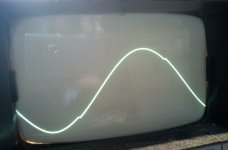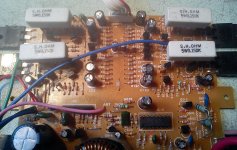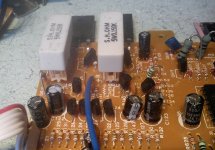I have a small, no name, class AB amplifier with a little distortion on the output. Attahced picture of scopes screen with 100 Hz sine on amplifiers output, notice the two notches.
Amp has no bias pots. Output transistors and emitter resistors seem to be good. When listening audio, then high frequencies sound normal but bass is a bit distorted.
I did not like waveforms on PS FETs, they are IRFZ44 with 28? ohms gate resistors, I replaced resistors with 47 ohms, also 1000uF rail caps with 2200uF caps.
Now I am out of ideas even where to start looking for the cause of the problem.
Amp has no bias pots. Output transistors and emitter resistors seem to be good. When listening audio, then high frequencies sound normal but bass is a bit distorted.
I did not like waveforms on PS FETs, they are IRFZ44 with 28? ohms gate resistors, I replaced resistors with 47 ohms, also 1000uF rail caps with 2200uF caps.
Now I am out of ideas even where to start looking for the cause of the problem.
Attachments
Last edited:
Hi
I took a quick look at your 100Hz output waveform. From the picture it looks like a lot of distortion. Since I do not know if the output to the load is capacitor or directly coupled it is difficult to say whether this is cross-over distortion or not. My guess is that one of the drive transistors driving the output transistors is malfunctioning. The way to tell is to use a regular Ohm meter with the amplifier un powered for a few minutes to let the power-supply capacitors discharge.
Since this is most probably a stereo unit compare the ohmic resistance between the various pins of the devices Right channel compared to Left channel. any significant (factors of more than 10) in resistance would indicate a failed device. Remember to measure both ways with your probes since there are rectifying junctions all over the place. Keep a log of good versus bad in a tabular form. Do the measurements first and the sit down and compare the results. These things are easier debugged on paper than with scope pictures.
Good luck and good tidings.
Hans J Weedon
<HJWeedon@verizon.net>
I took a quick look at your 100Hz output waveform. From the picture it looks like a lot of distortion. Since I do not know if the output to the load is capacitor or directly coupled it is difficult to say whether this is cross-over distortion or not. My guess is that one of the drive transistors driving the output transistors is malfunctioning. The way to tell is to use a regular Ohm meter with the amplifier un powered for a few minutes to let the power-supply capacitors discharge.
Since this is most probably a stereo unit compare the ohmic resistance between the various pins of the devices Right channel compared to Left channel. any significant (factors of more than 10) in resistance would indicate a failed device. Remember to measure both ways with your probes since there are rectifying junctions all over the place. Keep a log of good versus bad in a tabular form. Do the measurements first and the sit down and compare the results. These things are easier debugged on paper than with scope pictures.
Good luck and good tidings.
Hans J Weedon
<HJWeedon@verizon.net>
Find the bias transistor. It will have its collector and emitter directly connected to the bases of the output driver transistors. Increase the value of the resistor that is connected between the base and collector of the bias transistor. Go up just about 10% in value and recheck the output.
You may be able to cool the bias transistor with canned compressed gas (type used in place of compressed air) to see if that helps. If it does, changing the resistor will almost certainly solve the problem.
To use the compressed gas as a coolant, invert the can so that liquid is dispensed.
You may be able to cool the bias transistor with canned compressed gas (type used in place of compressed air) to see if that helps. If it does, changing the resistor will almost certainly solve the problem.
To use the compressed gas as a coolant, invert the can so that liquid is dispensed.
- Status
- This old topic is closed. If you want to reopen this topic, contact a moderator using the "Report Post" button.


